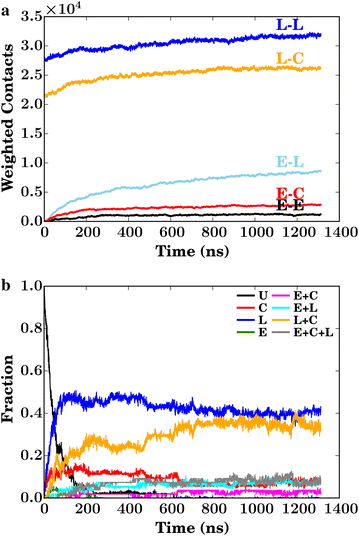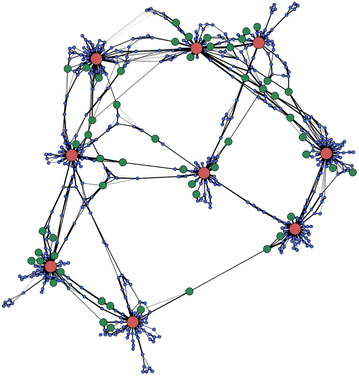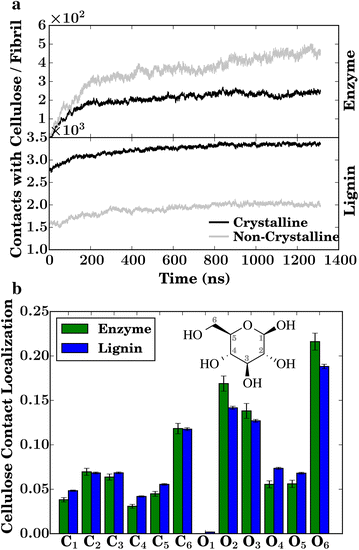Mechanism of lignin inhibition of enzymatic biomass deconstruction
- PMID: 26697106
- PMCID: PMC4687093
- DOI: 10.1186/s13068-015-0379-8
Mechanism of lignin inhibition of enzymatic biomass deconstruction
Abstract
Background: The conversion of plant biomass to ethanol via enzymatic cellulose hydrolysis offers a potentially sustainable route to biofuel production. However, the inhibition of enzymatic activity in pretreated biomass by lignin severely limits the efficiency of this process.
Results: By performing atomic-detail molecular dynamics simulation of a biomass model containing cellulose, lignin, and cellulases (TrCel7A), we elucidate detailed lignin inhibition mechanisms. We find that lignin binds preferentially both to the elements of cellulose to which the cellulases also preferentially bind (the hydrophobic faces) and also to the specific residues on the cellulose-binding module of the cellulase that are critical for cellulose binding of TrCel7A (Y466, Y492, and Y493).
Conclusions: Lignin thus binds exactly where for industrial purposes it is least desired, providing a simple explanation of why hydrolysis yields increase with lignin removal.
Keywords: Biofuel; Cel7A; Cellulose crystallinity; Lignin.
Figures










Similar articles
-
Lignin impairs Cel7A degradation of in vitro lignified cellulose by impeding enzyme movement and not by acting as a sink.Biotechnol Biofuels Bioprod. 2024 Jan 19;17(1):7. doi: 10.1186/s13068-023-02456-3. Biotechnol Biofuels Bioprod. 2024. PMID: 38243336 Free PMC article.
-
Engineering Cel7A carbohydrate binding module and linker for reduced lignin inhibition.Biotechnol Bioeng. 2016 Jun;113(6):1369-74. doi: 10.1002/bit.25889. Epub 2015 Dec 8. Biotechnol Bioeng. 2016. PMID: 26616493
-
Inhibition of enzymatic cellulolysis by phenolic compounds.Enzyme Microb Technol. 2011 Mar 7;48(3):239-47. doi: 10.1016/j.enzmictec.2010.11.004. Epub 2010 Nov 18. Enzyme Microb Technol. 2011. PMID: 22112906
-
Compounds inhibiting the bioconversion of hydrothermally pretreated lignocellulose.Appl Microbiol Biotechnol. 2015 May;99(10):4201-12. doi: 10.1007/s00253-015-6595-0. Epub 2015 Apr 24. Appl Microbiol Biotechnol. 2015. PMID: 25904131 Review.
-
Cellulolytic enzyme production and enzymatic hydrolysis for second-generation bioethanol production.Adv Biochem Eng Biotechnol. 2012;128:1-24. doi: 10.1007/10_2011_131. Adv Biochem Eng Biotechnol. 2012. PMID: 22231654 Review.
Cited by
-
Press water from the mechanical drying of Douglas-fir wood chips has multiple beneficial effects on lignocellulolytic fungi.Fungal Biol Biotechnol. 2022 May 23;9(1):10. doi: 10.1186/s40694-022-00141-y. Fungal Biol Biotechnol. 2022. PMID: 35606847 Free PMC article.
-
Visualising recalcitrance by colocalisation of cellulase, lignin and cellulose in pretreated pine biomass using fluorescence microscopy.Sci Rep. 2017 Mar 10;7:44386. doi: 10.1038/srep44386. Sci Rep. 2017. PMID: 28281670 Free PMC article.
-
Plant Terpenoid Permeability through Biological Membranes Explored via Molecular Simulations.J Phys Chem B. 2023 Feb 9;127(5):1144-1157. doi: 10.1021/acs.jpcb.2c07209. Epub 2023 Jan 30. J Phys Chem B. 2023. PMID: 36717085 Free PMC article.
-
Recent advances in understanding the effects of lignin structural characteristics on enzymatic hydrolysis.Biotechnol Biofuels. 2021 Oct 20;14(1):205. doi: 10.1186/s13068-021-02054-1. Biotechnol Biofuels. 2021. PMID: 34670604 Free PMC article. Review.
-
Recent Advances in the Biosynthesis of Polyhydroxyalkanoates from Lignocellulosic Feedstocks.Life (Basel). 2021 Aug 10;11(8):807. doi: 10.3390/life11080807. Life (Basel). 2021. PMID: 34440551 Free PMC article. Review.
References
-
- Jorgensen H, Kristensen JB, Felby C. Enzymatic conversion of lignocellulose into fermentable sugars: challenges and opportunities. Biofuels Bioprod Biorefin. 2007;1(2):119–134. doi: 10.1002/bbb.4. - DOI
-
- Yang B, Wyman CE. Pretreatment: the key to unlocking low-cost cellulosic ethanol. Biofuel Bioprod Biorefining. 2008;2(1):26–40. doi: 10.1002/bbb.49. - DOI
LinkOut - more resources
Full Text Sources
Other Literature Sources

